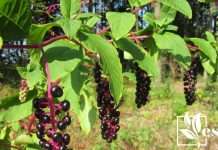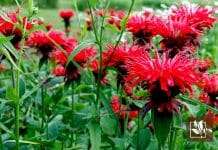Plants that repel Japanese beetles have a strong odor and intense flavor that these tiny bugs hate. Garlic and catnip are some of the plants you can use to repel Japanese beetles.
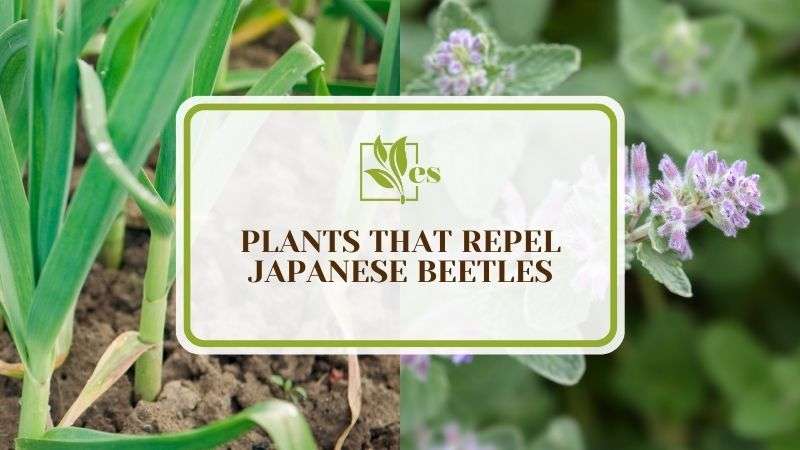
What are the annuals that Japanese beetles don’t like? How to grow them?
Find the answers to these questions in this article. Also, read more about plants that can repel snakes and plants that can repel rats, both very useful for a garden.
JUMP TO TOPIC
List of Plants That Keep Japanese Beetles Away
Japanese beetles are small insects, but their threat to your garden should not be underestimated. If you allow these insects to remain in your yard unchecked, they will munch on your plants and cause extensive harm.
If you have plants that attract Japanese beetles in your garden, you can always practice companion planting with these plants for beetle control.
Here’s a list of plants for you to choose from:
1. Garlic
Garlic, an amaryllis family perennial plant, is grown for its flavorful bulbs. The plant is homegrown in Central Asia but grows wild in Italy and southern France. It is a staple in many national dishes. The bulbs have a strong onion-like fragrance and a harsh flavor and are not typically eaten fresh.

Garlic is typically planted as an annual crop and is propagated through the planting of cloves or top bulbils. However, seeds can also be utilized.
Garlic is one of the greatest plants to grow in your yard if you want to keep Japanese beetles away. Japanese beetles dislike many plants with strong scents, and garlic certainly helps.
– Growing Season
Garlic is often planted in the fall (between late September and November). Ideally, it is recommended to plant garlic 6 to 8 weeks before the first frost when the ground freezes, in hard frost locations.
– Specific Needs
Garlic requires chilly conditions to grow in the fall. Sow the garlic four to six weeks before the ground freezes in areas with cold winters. Plant garlic throughout the winter but before February in cooler climates.
Add a lot of organic matter, such as compost or well-aged manure, unless your soil is already loose. Separate the garlic cloves from the bulb (like you do when cooking but without peeling them)—plant garlic cloves 1 inch deep. The larger end of the bulb that was at the bottom should be at the bottom of the hole. You can plant the pieces deeper if your winters are colder.
2. Catnip
Catnip is a strong and weedy herbaceous perennial native to Eurasia in the mint family; nevertheless, other selections on the list may appeal to you. Catnip has a rangy habit with green to gray-green foliage on erect, branching stems.
It features the distinctive square stems of mint plants and opposing leaves with 1-inch petioles, as do other members of the mint family. Fine hairs cover the light green stems and petioles.
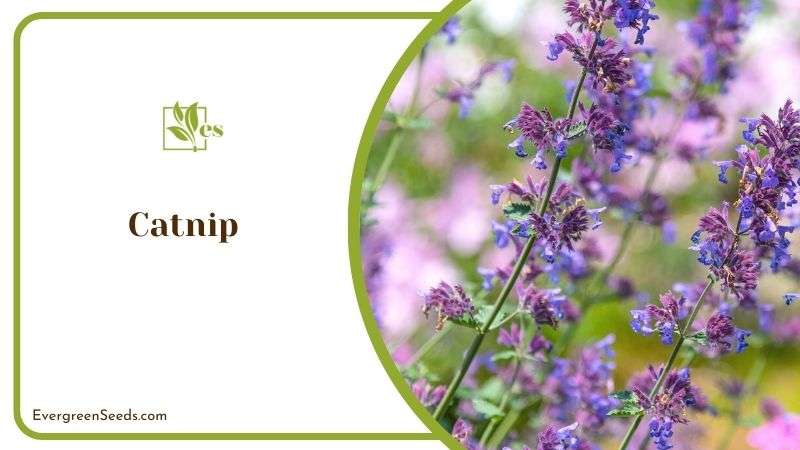
Japanese beetles are not fond of catnip plants as they rigorously control Japanese beetle damage. They despise the smell and will avoid any catnip plants you choose to place in your garden area. The plant also repulses cucumber beetles, the name given to members of two genres of beetles.
The only disadvantage of growing catnip in your yard is that it may captivate stray cats. You may notice more stray cats entering your yard to munch on the leaves of your catnip plants, which may indicate that some of the other options on the list are more appealing to you if you want to avoid cats.
– Growing Season
Plants bloom from late spring to fall, lasting one to two months. If you plant your catnip in the spring, the harvesting season is late spring to early fall. Please wait until your catnip plant blooms before harvesting it since flowering catnip plants have stronger and more scented leaves.
– Specific Needs
Catnip grows best in full sun on medium, well-drained soil, although it can also thrive in partial shade and poor soil. Plant size is heavily influenced by soil moisture and fertility levels. This plant is drought-tolerant once established.
If cultivated as an ornamental, pinching the plants as they come up in the spring will assist in generating a more dense, well-shaped plant.
3. White Geraniums
White geraniums are distinguished by dazzling white flower clusters, vivid scalloped leaves, and bushy, 4 – 5 inch blossoms.
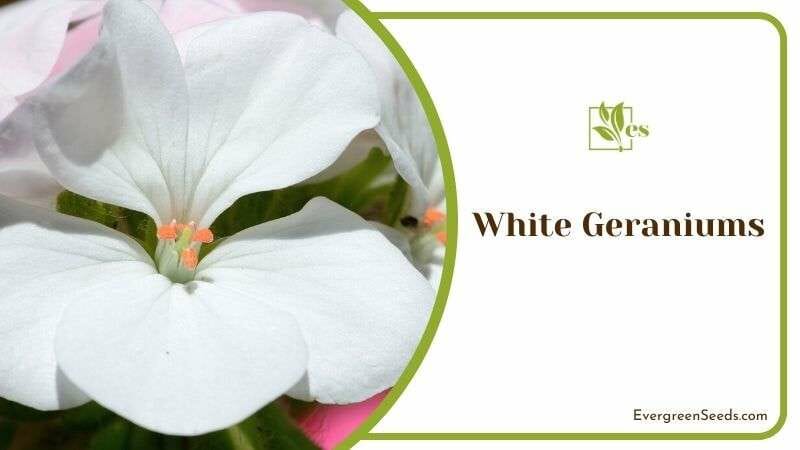
Geraniums are another plant to consider if you want to cultivate something attractive in your garden. This lovely shrub will keep Japanese beetles at bay while also adding to the aesthetic of your yard.
Japanese beetle grubs and other beneficial nematodes like geraniums. However, geraniums resist Japanese beetles naturally by putting them in a narcotic state for 12-18 hours. When beetles eat the petals, they become dizzy from the natural chemicals in the geranium and fall off the plant.
Milky spore granular should be applied before grubs hatch in the spring, summer, and fall for two years to get maximum spore levels in the soil. Applications can be made at any time of year as long as the ground is not frozen.
– Growing Season
Geraniums are admired for their extended flowering season, which begins in the spring and can extend into the fall. Plants kept at temperatures between 45 and 50 degrees Fahrenheit may also bloom from winter to early spring.
In March, prune your potted geraniums by removing one-half to two-thirds of each plant. They will start growing again in a few days and should mature into lovely plants by May.
– Specific Needs
Geraniums prefer well-draining soil that keeps moisture. They are drought-hardy in many areas and can grow in practically any sort of soil. A potting soil, perlite, and peat moss blend can be added to the soil. Periodic fertilization with a 5-10-5 fertilizer is beneficial to white geranium cultivars.
Geraniums thrive in various containers as long as they include drainage holes. The key to growing geraniums in pots successfully is to keep them in bright light and away from strong winds.
4. Common Rue
Rue is an evergreen with glandular foliage. The feathery, pinnately complex leaves are normally two or three leaflets long and are gray-green or blue-green. The dull yellow flowers bloom in groups and produce lobed capsules containing many seeds.
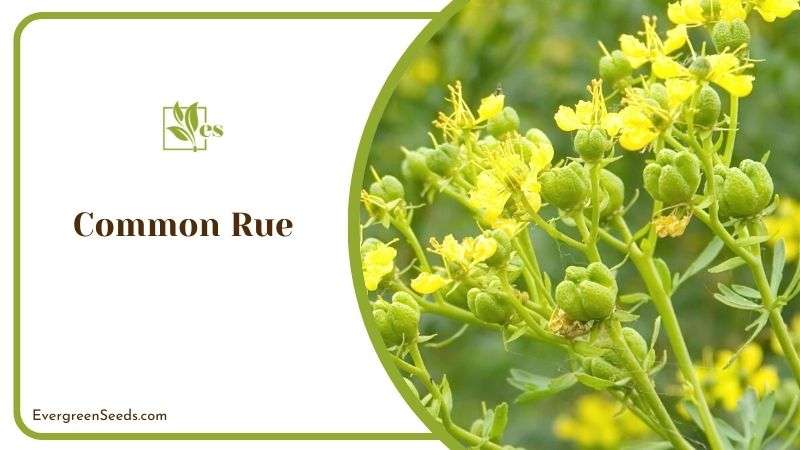
Rue is a plant with a pungent smell that can keep numerous animals and garden pests away from your outdoor space. It can help in Japanese beetle control, but it can also keep cats and dogs away from your yard.
– Growing Season
The ideal time to plant Rue is when average temps hit 70 degrees. It’s a type of perennial herb. It may stay green all year if you live in a planting zone with moderate winters. If you live in a harsher climate, the plant will die off but return as soon as the weather warms up.
– Specific Needs
Rue prefers well-drained soil but will flourish in rocky, dry soil where other plants struggle. It thrives best in full sun and is drought-hardy, so it rarely needs to be watered. Cover the plants with row covers or chopped-up leaves to resist weeds and retain water. Every three weeks, thoroughly water the plants.
5. Silver Maple
Silver maple, also known as soft maple or white maple, is a tall, spreading tree in the soapberry family that is widely used as a fast-growing shade tree.
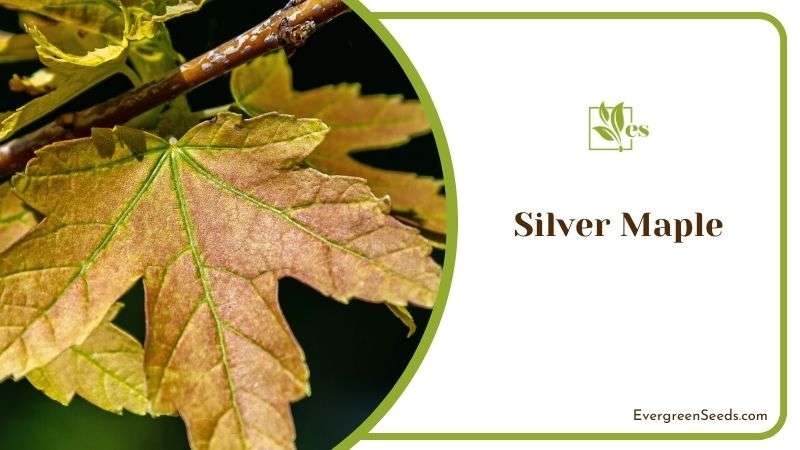
Unlike the Norway maple and Japanese maple, which allow beetles to feed on themselves, silver maple is used to control Japanese beetles.
– Growing Season
The optimum time to plant these trees is in the spring after the frost has melted. The trees may grow swiftly if the soil is moist and the climate is pleasant.
– Specific Needs
Silver maples thrive in moist, slightly acidic soil. They are drought resilient but are most known for their capacity to survive in standing water for extended periods. These were frequently planted along river banks or the edges of other rivers for erosion prevention due to their water tolerance. They can withstand high water levels in the spring and low water levels in the summer.
6. SweetGum
These are huge trees with palmate leaves that alternate and have three to seven lobes. On the same tree, the plants produce tall spikes of greenish male flowers and circular hanging clusters of female flowers. The fruits are spiny, dark brown balls known as capsule aggregates. Each capsule contains multiple little seeds; the fruits can last all winter.
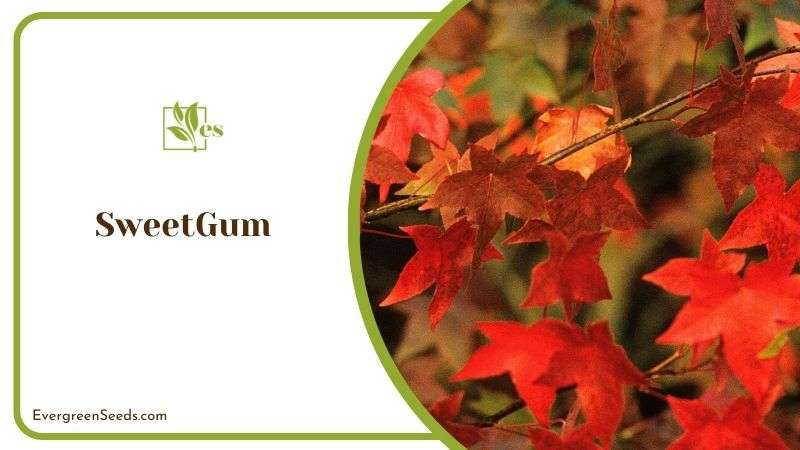
While these plants may suffer from mild Japanese beetle damage sometimes, the good news is that these natural predators will rapidly lose interest in them because they aren’t as delectable to them as some other plants are.
– Growing Season
The ideal season to grow this deciduous tree is summer. Flowers bloom from December to May and range from brilliant red to pink or orange.
– Specific Needs
This flowering tree requires full sun or light shade to thrive. It can grow in almost any soil, from sandy to clay, acidic to slightly alkaline. It has many superficial roots but some deep ones that like moist, deep soil. They can withstand winter in USDA plant hardiness zones 5 through 9.
7. Leek
Leeks, also known as “the gourmet’s onion,” are related to onions and garlic but have flat leaves rather than tubular leaves and little bulb growth. They’re simple to produce and delicious, having a distinct flavor reminiscent of a mild onion. The thick leaf bases and little developed bulb resemble a large green onion.
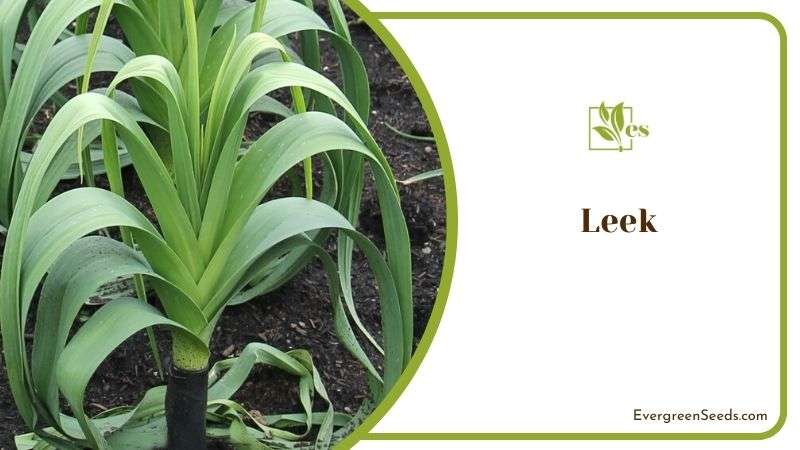
Plant leek to attract birds, tachinid insects, and nematodes. These bugs and birds are the most effective at pest control and efficient at eating and eliminating Japanese beetles. If this doesn’t work, let’s see more about what can be done.
You can make homemade Japanese beetle traps. These traps are baited with lures and may contain various repulsive organic components like neem oil or cedar oil. These lures may smell like flowers or insect pheromones (sometimes both).
These smells move through the air, and the beetles use their antenna to pick up on the scent, urging the insect to come over. Once they are over, they fall prey to the repellents and die.
– Growing Season
Leeks are wonderful winter vegetables that are easy to grow but require some time and attention – they are typically sown in containers or a seed bed and then relocated to their final location a few months later. Plant in the spring, and you’ll be harvesting from autumn to late winter.
They also have an extended growing season (80-120 days). In the short-season, start seeds indoors 4 to 10 weeks before the usual last frost date and move the seedlings into the garden.
– Specific Needs
Plant leeks in a sunny place with healthy, well-drained soil. Leeks grow well in standard garden beds, raised beds, and even tall containers, so use whatever method works best for you. When planting leeks, space them 6 inches apart. To thrive, leeks require plenty of nitrogen and steady soil moisture.
8. Tansy
Tansy is a herbaceous perennial plant that is frequently considered a weed. Tansy plants are commonly found in the United States, especially in temperate areas. It is a flowering plant with compound leaves that are finely split and yellow button-like blooms. It has a thick, slightly reddish, erect stem that is normally smooth and grows 20 – 59 inches tall, branching near the top.
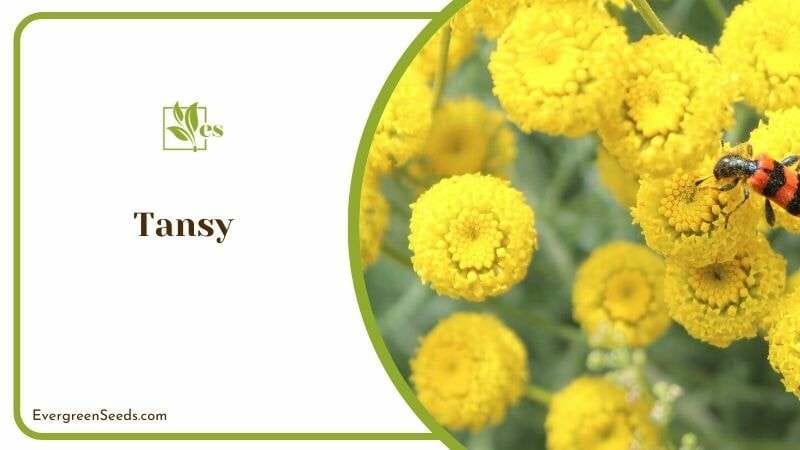
Tansy plants are one of the best options to keep Japanese beetles away from your garden. It has a strong scent, one similar to rosemary. The scent acts as a strong repellent against beetles and bugs.
– Growing Season
Tansy is a fragrant plant found in disturbed areas, rough grasslands, riverbanks, and roadside verges. From July through October, it features fern-like foliage and yellow flower heads that develop in bunches.
– Specific Needs
Tansy may thrive in either full sun or moderate shade. It does best in fertile, well-drained soil and areas with minimal vegetation. Tansy is frequently used as a companion plant in the garden since it repels numerous pests, and it has even been used to treat parasites internally in humans and animals in the past.
Conclusion
Japanese beetles can be tackled by an appropriate approach taken for gardening. Instead of using pesticide sprays or artificial chemicals to deter bugs, you can always adopt organic and healthy solutions.
The mentioned plants are easy to grow and maintain and do not require exceptional care, just remember the following:
- Perennial plants that repel Japanese beetles include catnip, garlic, and white geraniums.
- The flowers to deter Japanese beetles range from geraniums to leeks to catnip.
- Japanese beetle-resistant shrubs include sweet gum.
- Do Japanese beetles like hydrangeas? No, they are not attracted to these plants.
- Lindens, birch, and European horse-chestnut are also good alternatives if you are looking for shade trees.
Now that you have an exhaustive list of options, which one suits your taste?
References
- https://extension.umn.edu/yard-and-garden-news/Japanese-beetles-and-four-oclock-flowers
- https://www.denverlibrary.org/blog/research/lisa/coping-Japanese-beetle-invasion
- https://www.wiscontext.org/5-ways-battle-Japanese-beetles-while-protecting-pollinators


